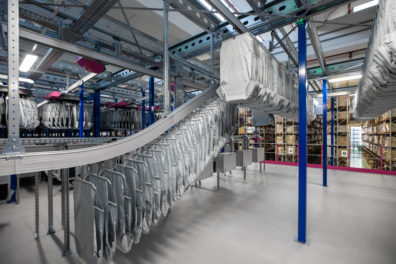BEUMER Group’s pouch technology meets omnichannel operators’ demand for leaner e-commerce fulfilment
BEUMER Group – a leading global supplier of automated material handling systems – has developed its BG Pouch System® as the perfect solution for omnichannel and D2C operators in search of a solution for leaner e-commerce fulfilment. The innovative system expands BEUMER Group’s offering for the warehouse and distribution industry.
Over the past several years, and particularly since the Covid pandemic, the biggest shift in the landscape has of course been the soaring growth of e-commerce. This has propelled many traditional retailers into establishing online stores to complement their physical stores in order to compete in the online world and reach more customers. At the same time there is a clear trend in customers returning to physical stores.
The combination of these two trends means that increasing numbers of retailers are finding that they must be present in both the physical and the digital worlds. The evolving omnichannel business model, combining bricks-and-mortar retail with e-commerce, is making order fulfilment more complex for logistics providers. Care must be taken to avoid these challenges, such as the high cost of handling returns.
Leaner handling of returned items
Research shows that around 30% of all products ordered online are returned, with a resultant major cost impact on the distributor. Two factors that greatly increase this burden are the time it takes staff to handle and reclassify products, and the cost in extra space needed to handle and store the goods. The BG Pouch System is designed to mitigate both these problems.
This specialised e-commerce fulfilment technology is able to transport, sort, sequence and store both outbound and returned items in a much leaner sequence, requiring less manual intervention, and reducing the number of product touches in the returns process by over 50%.
This simplified handling of returns is achieved by placing each item directly into a pouch rather than sending it back to the regular storage area. The pouch system serves as an interim storage buffer for returned items. When goods are sold again they can be sent for sortation and shipment directly from the dynamic buffer without ever being sent back to the main storage area and without having to be re-picked. As such, the pouch system eliminates a tremendous amount of unnecessary manual handling to dramatically speed up and smooth intralogistics flows, allowing predictive picking to significantly reduce handling peaks.
The BG Pouch System is also ideal for sites that are space constrained, as being ceiling mounted it represents a massive saving on space and enables easy deployment when floor area is a limiting factor. Additionally, as a modular system the BG Pouch System can also be readily scaled up when required with minimal installation time.
Each BG Pouch System module can handle more than 10,000 pouches per hour. The system runs on a contactless magnetic drive that gives friction-free operation with the complete avoidance of energy- and maintenance-heavy pneumatics, which means lower operating costs through minimal wear on mechanical parts, less maintenance, a reduced number of spares and a minimum of cleaning requirements.
The system is also highly flexible, being able to handle a wide range of packages from cartons to polybags, and having a high weight capacity of up to 7kg per pouch, making it ideally suited to handling a wide product profile, including print and media, pharmaceuticals and beauty products, and electronics.
Stephan Heessels, Director for BEUMER Group Logistic Systems, comments: “We see a huge potential for our modern version of the pouch technology. The handling of returns is going to be an ongoing and growing challenge, and omnichannel distributors need to be able to optimise their processes for faster goods-to-consumer cycles and a vastly lower need for operators to touch items.”

 Our Commitment to Sustainable DevelopmentAs an independent and family-owned company, BEUMER Group is deeply committed to the principles of sustainable development. Through strong partnerships we have developed a deep understanding of the sustainability issues of our key industries and enable our partners to achieve their sustainability goals and targets.Learn more
Our Commitment to Sustainable DevelopmentAs an independent and family-owned company, BEUMER Group is deeply committed to the principles of sustainable development. Through strong partnerships we have developed a deep understanding of the sustainability issues of our key industries and enable our partners to achieve their sustainability goals and targets.Learn more

